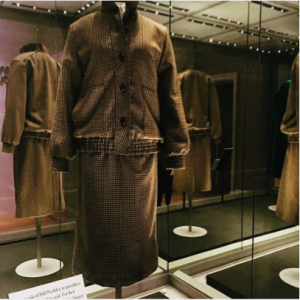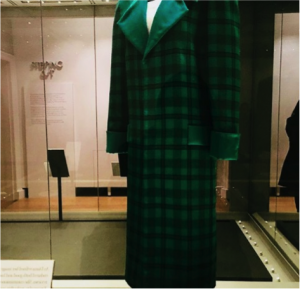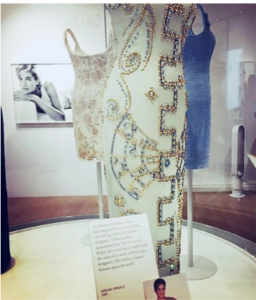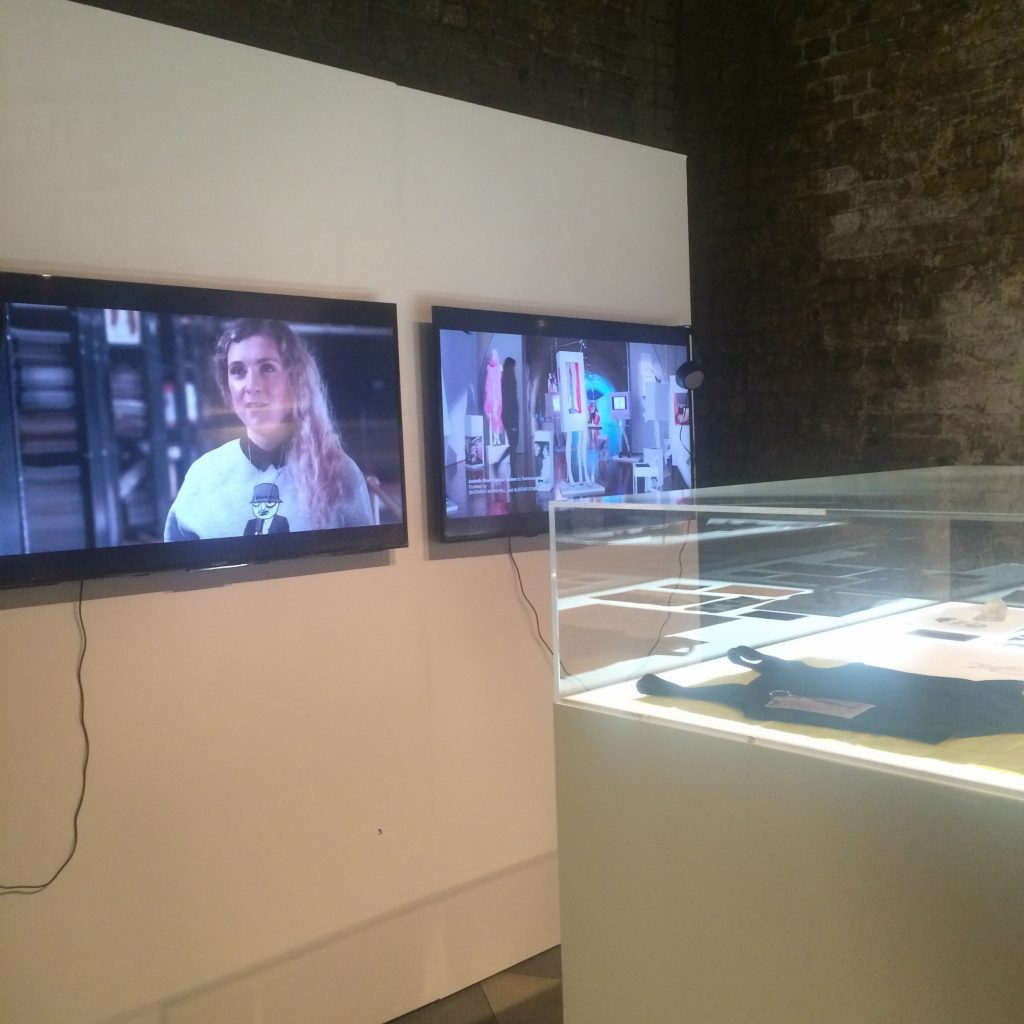Final year Fashion and Design History student Annie Wright reviews the V&A’s Fashion gallery.
Victoria and Albert Fashion Gallery Review
Annie Wright
The Victoria and Albert Museum “was established in 1852, following the popular success of the great exhibition of 1851”[1]. Textiles were a part of the collection from early on, but “initially dress was acquired for the technical quality and design of the woven, printed or embroidered textiles from which it was made rather than for its fashionable significance”[2]. However, “by the 1890s the aesthetic appeal of dress became increasingly appreciated amidst a wider interest in British history”[3]. It was in 1957 that “the museums first dedicated fashion curator was appointed”[4]. And in 1960, one of the museums first fashion exhibitions, A Lady of Fashion”[5]. In 1971 “Sir Cecil Beaton persuaded his aristocratic and stylish friends to donate 1,200 items of haute couture to the V&A for an exhibition Fashion: An Anthology”[6]. Which would become the basis of the galleries twentieth century collection. And the exhibition, with its “dramatic styling, marked the beginning of modern fashion curation”[7]. The gallery since has only grown in popularity, with landmark exhibitions such as Alexander McQueen: Savage Beauty in 2015, which “became the museum’s most visited exhibition”[8].

Figure 1, Peshwaz, Late 18th century to early 19th century, India, Victoria and Albert Museum, https://collections.vam.ac.uk/item/O470782/peshwaz/.

Figure 2, Sun Sun Company, Qipao, 1930, Shanghai, Victoria and Albert Museum, https://collections.vam.ac.uk/item/O1151302/qipao-sun-sun-company/

Figure 3, Dress Fabric, 1600-1700, Isfahan, Victoria and Albert Museum, https://collections.vam.ac.uk/item/O86626/dress-fabric-unknown/.
The V&A fashion gallery provides an excellent timeline of western upper-class fashion, which spans from the mid to late 18th century to present day. However, the fashion gallery largely excludes non-western garments from their timeline, which dangerously perpetuates the long-standing colonial narrative, that throughout history has been pushed by museums, that non-western societies are inferior. Museums are a place of education, and “continue to be one of society’s most trusted institutions”[9], therefore the public may not question this narrative. Bernie Macdonald, the director of decolonizing initiatives at San Diego Museum of Man, states “Museums were birthed from the colonial endeavour”[10] and “Museums and collectors not only claimed ownership over the material object, but also drafted their own narratives and stories of the “primitive” people who made them and their uses”[11]. The V&A is guilty of creating their own narrative, as the exclusion of garments from non-western cultures from their fashion timeline perpetuates the idea of western superiority and supports the idea of the oriental “other”. The issue is not regarding the V&A needing to acquire garments from non- western cultures, as they already have plenty, which can be found in their other galleries. Like the British and European galleries, the South Asia (Figure 1), Chinese (Figure 2), Islamic Middle East (Figure 3), Japanese (Figure 4) and Korean (Figure 5) galleries all contain both textiles and items of clothing. However, unlike the British and European galleries, these items are not also included in the fashion gallery. Out of nearly 200 items on display only a handful are non-western, including a dress by Cheedonian Boutique (Figure 6) and a skirt and coat by Yohji Yamamoto (Figure 7).

Figure 4, Kimono, 1870-1890, Japan, Victoria and Albert Museum, Personal Photograph by the Author, 10 March, 2023.

Figure 5, Samo, 19th century, Korea, Victoria and Albert Museum, https://collections.vam.ac.uk/item/O485775/samo-hat-unknown/.

Figure 6, Cheedoniam Boutique, Dress, 1994, Sierra Leone, Victoria and Albert Museum, https://collections.vam.ac.uk/item/O1644195/dress-cheedonian-boutique/.

Figure 7, Yohji Yamamoto, Skirt, 2004-2005, Japan, Victoria and Albert Museum, https://collections.vam.ac.uk/item/O1245355/skirt-yohji-yamamoto/.
Another issue is that item labels are small, usually around 50 words or less, which creates an issue when an item requires context. For example, one display in the gallery includes a shawl from 1860-65, which was made in France but is inspired by Indian textiles (Figure 8). But with the label’s word count being small, the colonial history may not be apparent to the audience. There is more information about the shawl on the website, however it is unlikely that the public would look there or even know to look there.
On the July 2nd 2022 until the April 16th 2023, the V&A held an exhibition called Africa Fashion, which was “the UK’s frst major exploration of 20th-century style across Africa and the diaspora”[12]. The exhibition “drew the highest attendance figures for the event since 2019”[13] and was even visited by king Charles III. The exhibition was definitely a step in the right direction for the fashion galleries at the museum and showed that the museum is capable of decolonising its displays. With even the mannequins being remade to look less Eurocentric as there is “a lack of diversity in commercially available mannequins”[14]. Whilst it is great that this exhibition was held, the fact it was only temporary still contributes to Eurocentric narrative. There needs to be these exhibitions but also more garments in the permanent collection.
Unfortunately, the lack of inclusivity in the permanent fashion gallery does not just come from Eurocentric and colonial ideas about museums but also funding. The museum “ is an executive non-departmental public body, sponsored by the Department for Culture, Media and Sport”[15], therefore changing and adding to the fashion gallery may not be as easy. But with exhibitions like Africa fashion showing that the museum is ready and wanting to decolonise its practices. And block buster expiations like the Coco Channel one currently being held, will bring in more money for the museum. There is hope for change soon.
References
[1] Claire Wilcox, “Introduction”, V&A Gallery of Fashion, edited by Claire Wilcox and Jenny Lister, (V&A Publishing, 2016), 6.
[2] Claire Wilcox, “Introduction”, V&A Gallery of Fashion, edited by Claire Wilcox and Jenny Lister, (V&A Publishing, 2016), 6.
[3] Claire Wilcox, “Introduction”, V&A Gallery of Fashion, edited by Claire Wilcox and Jenny Lister, (V&A Publishing, 2016), 6.
[4] Claire Wilcox, “Introduction”, V&A Gallery of Fashion, edited by Claire Wilcox and Jenny Lister, (V&A Publishing, 2016),, 7.
[5] Claire Wilcox, “Introduction”, V&A Gallery of Fashion, edited by Claire Wilcox and Jenny Lister, (V&A Publishing, 2016), 7.
[6] Claire Wilcox, “Introduction”, V&A Gallery of Fashion, edited by Claire Wilcox and Jenny Lister, (V&A Publishing, 2016), 7.
[7] Claire Wilcox, “Introduction”, V&A Gallery of Fashion, edited by Claire Wilcox and Jenny Lister, (V&A Publishing, 2016), 7.
[8] Claire Wilcox, “Introduction”, V&A Gallery of Fashion, edited by Claire Wilcox and Jenny Lister, (V&A Publishing, 2016), 8.
[9] Robert R. Janes, Richard Sandell, “Posterity has arrived: The necessary emergence of museum activism”, Museum Activism, edited by Robert R. Janes, Richard Sandell, (Routledge, 2019), 6.
[10] Brandie Macdonald, “Pausing, Reflection, and Action: Decolonizing Museum Practices”, Journal of Museum Education, Volume 47, Issue 1, 2022, 10.
[11] Brandie Macdonald, “Pausing, Reflection, and Action: Decolonizing Museum Practices”, Journal of Museum Education, Volume 47, Issue 1, 2022, 10.
[12] “A year in highlights”, V&A Annual Review 2022-23, 6.
[13] “Performance against strategic objectives”, Victoria and Albert Museum Annual Report and Accounts 2022-23, 10.
[14] Rachel Lee, “Why representation matters: Creating the Africa Fashion mannequin”, Victoria and Albert Museum, January 25, 2023, https://www.vam.ac.uk/blog/projects/why-representation-matters-creating-the-africa-fashion-mannequin.
[15] Victoria and Albert Museum, GOV.UK, https://www.gov.uk/government/organisations/victoria-and-albert-museum.
































